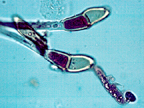
Uredinomycetes
Order: Uredinales (Rusts)
This class is composed of a single order of obligate parasites that are pathogenic to ferns, gymnosperms and flowering plants. Basidiocarps are not produced in this order and the life cycle is quite different than that of the Basidiomycetes. In Puccinia graminis (Wheat Rust), the species that will be used as the representative for this order, there are five spore stages that are produced and two hosts are required in the completion ofthe life cyle. The five stages produced are:
As a means of comparing the life cycle of Puccinia graminis with that of the mushroom life cycle, a summary of the life cycle will begin with the basidiospore.
Basidium (Stage IV)
Puccinia graminis is heterothallic and basidia
produce basidiospores that are of two mating types, designated as a1 and a2,
Basidiospores are capable of only infecting the leaves of Berberis sp. (barberry),
the alternative host for this species. Species that require two hosts to complete
their life cycles are said to be heteroecious. The cells of the teliospore
germinates to produce a short germ tube that will develop into a basidium that is
essentially transversely septate.
Spermogonium (Stage 0)
The spermogonium stage (Fig. 2) produces the sex
organs in rusts. They are produced on the upper surface of the Berberis
(barberry) leaf. Since the spermogonia are derived from basidiospores, they are of two
mating types. They are flasked-shaped and produce spore-like spermatia which ooze
out, from the neck, in a sweet-smelling nectar. Also growing from the necks are receptive
hyphae. The spermogonia are visited by flies which are attracted by the nectar
secretions, and as they visit different spermagonia, spermatia of both mating types,
adhere to their bodies and are transferred to receptive hyphae of the other mating types.
This begins the dikaryon stage of the life cycle.
Aecium (Stage I)
The aecium stage is directly linked to the
spermagonium stage. When spermatia are transfered to compatible receptive hyphae,
this begins the dikaryotic stage of the life cycle and directly produces the aecium on the
lower surface of the barberry leaf. The aecium is an upside-down,sac-shaped
structure (Fig. 4)in which chains of aeciospores are formed.The aeciospores burst
through the lower surface of the leaf and are dispersed by wind.
 |
Figure 4. Aecium stage emerging from the lower surface of the Berberis leaf. The aeciospores are borne in chains and are held together by little rectangular cells called disjunctors. |
Uredium (Stage II)
The aeciospores cannot reinfect the barberry host.
Instead infection can only occur on the primary host, Triticum aestivum (wheat),
where a new dikaryotic infection occurs. When two hosts are required in the completion of
a rust life cycle, the rust is said to be heteroecious. The wheat is said to be the
primary host while barberry is said to be the alternate host. The dikaryons
infect the wheat stems and leaves and will form uredia that contain orange-brown urediospores
(Fig. 5). This order is commonly called the rusts because of the orange-brown (rusty)
colored pustules that form on the wheat plant after the urediospores have broken through
the epidermal surface. The urediospores are comparable to conidia in that they will
reinfect wheat plants and produce more uredia and ureiospores. This stage begins during
summer and continues until late summer in North America.
 |
Figure 5. A prepared slide showing the rust spores as they break the host epidermis. This is the repeating stage of the life cycle and continually reinfects wheat from early spring to summer. |
Telium (Stage III)
Towards the end of summer, the uredium begins to
produce teliospores (Fig. 6), a dark, thick-walled, two celled spore. Teliospores
do not produce telia! It is the uredium that gradually becomes a telium by producing more
and more teliospores. Because of the color of the teliospores,the telium is black.
Following karyogamy, the teliospore overwinters. Meiosis takes place in each cell of the
teliospore, in spring,and germinates to form the promycelium (=basidium). The
promycelium becomes transversely septate, forming four cells. Each cell produce a sterigma
and a basidiospore, and this now completes the life cycle.
 |
Figure 6. Teliospores, on the wheat plant. The teliospores are dark, two celled, thick walled spores. These spores overwinter before producing the basidiospore stage. |
Comparison of the Puccinia graminis and mushroom life cycle
The monokaryon derived from the basidiospore, in the rusts, are heterothallic as in the mushroom life cycle. However, the dikaryon phase and its formation, in the life cycle of the rusts, is extended and more complex in comparison:
Go to Next Page